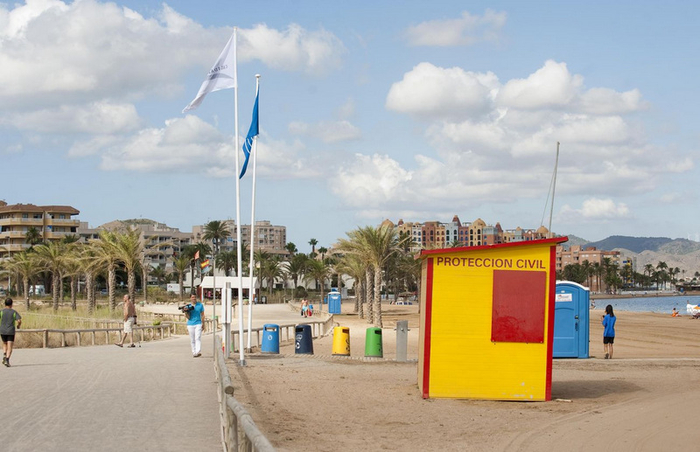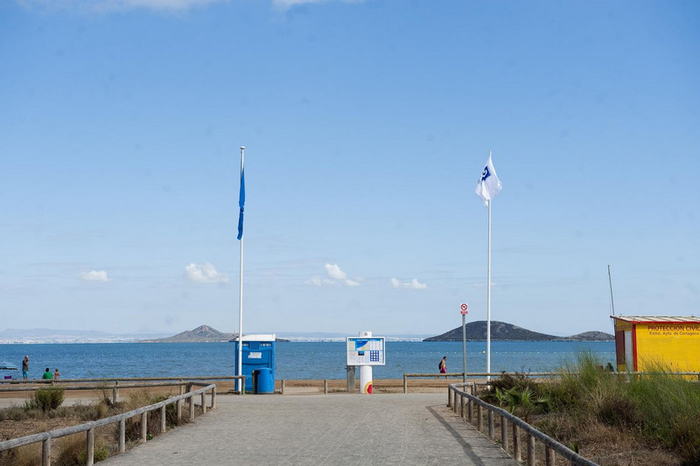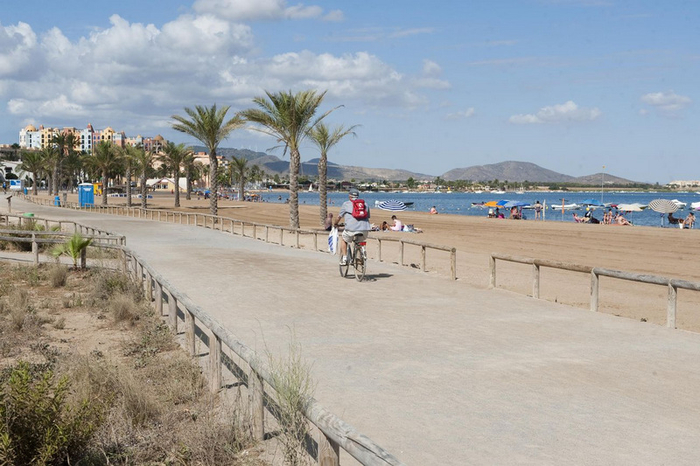- Region
- Vega baja
- Marina Alta
- Marina Baixa
- Alicante
- Baix Vinalopo
- Alto & Mitja Vinalopo
-
ALL TOWNS
- ALICANTE TOWNS
- Albatera
- Alfaz Del Pi
- Alicante City
- Alcoy
- Almoradi
- Benitatxell
- Bigastro
- Benferri
- Benidorm
- Calosa de Segura
- Calpe
- Catral
- Costa Blanca
- Cox
- Daya Vieja
- Denia
- Elche
- Elda
- Granja de Rocamora
- Guardamar del Segura
- Jacarilla
- Los Montesinos
- Orihuela
- Pedreguer
- Pilar de Horadada
- Playa Flamenca
- Quesada
- Rafal
- Redovan
- Rojales
- San Isidro
- Torrevieja
- Comunidad Valenciana
Cartagena beaches: Playa Paraiso
Playa Paraíso is a natural corner of the Mar Menor by the Marchamalo salt flats
The stretch of sand known as Playa Paraíso is an extension of the beach of Playa Honda, and is differentiated by the fact that it is backed onto not by urban development but by the old salt flats of Marchamalo, from which it is separated by a wide seafront path and landscaped area.
The fine sandy beach faces north-west and is flanked on the eastern side by Playa de los Alemanes, the total distance of this beach being 800 metres, although it is difficult to see where one beach ends and another begins, the three neighbouring beaches merging seamlessly one into another.
There are few remnants of the days when this whole area was used to harvest sea salt as much of the original saltpans lie buried beneath the modern developments fringing the Mar Menor, so this area has been given the status of a reserve and is very much a natural haven for birdlife.
As befits an area next to a wildlife and bird reserve, the zones immediately behind the beach have been sympathetically landscaped, so beachgoers can enjoy an attractive corner in which to walk or cycle, reflecting the environmental sensitivity of this area of the Mar Menor.

The Mar Menor is a unique environment, its beaches inside the circle of Europe's largest saltwater lake, which covers a surface area of nearly 170 square kilometres, with 70 kilometres of internal coastline. This is separated from the Mediterranean by a 22km long strip of land, La Manga del Mar Menor, which is connected to the Mediterranean via a canal channel, feeding the Mar Menor with natural saltwater.
It has shallow fringes, which slope gently, and is only 7 metres deep in the centre, so the water temperature is warmer than that of the Mediterranean, particularly around the edges where it is possible to wade out 50 metres from the shore and still only be waist deep.
Murcia is the warmest mainland region in Spain, and has an average temperature of 18 degrees, which makes it perfect for year-round watersports activity and bathers can enjoy the waters of the Mar Menor for most of the year. The water in the Mar Menor is not tidal and has no currents or waves, so is perfect for family bathing or watersport beginners.

Information about the Mar Menor is displayed on informative panels installed at the beach, which also offers recycling collection points, bins, wooden walkways, footwashes, toilets, a beachbar, lifeguard service, children's play area, and hire zone for sun loungers and umbrellas.
Access to the beach is either from Playa Honda or from the small residential area of the Playa de los Alemanes: for those new to the area the more recommended route by car is to park at the eastern end of the beach of Playa Honda (the road access to Playa de los Alemanes is picturesque but complicated!).

Safety precautions for bathers
This is a Mar Menor beach and it is advisable to observe the following safety precautions when bathing:
Most of the Mar Menor beaches have very gently sloping shelves, meaning that bathers can walk a considerable distance from the shore and still only be waist high in the water. These shore fringes are also very warm, heating up more than the deeper waters, or the Mediterranean coastline, particularly during the hot summer months.
Many beaches are also protected by netting to exclude jellyfish.
This creates safe bathing areas for families but also leads to a situation which can be life threatening, as the safety of the beaches results in many elderly bathers bathing alone.This in itself is not life threatening, but every year there are unnecessary deaths when bathers suffer a heart attack, stroke, faint or have a dizzy spell of some sort whilst bathing alone, slipping into the water without anybody else being aware that this has happened.
The transition from hot beach to cold water can shock the body, causing dizziness or fainting, so it is advisable to splash the body with water to cool down before wading out into the Mar Menor or Mediterranean.
Even though there are lifeguards, accidents happen and every year there are unnecessary fatalities, the simple rule being if you have a medical condition, are taking medication, or are of advanced age, don´t bathe alone, no matter how shallow and calm the water is.
And for all ages, a red flag means do not bathe, particularly on the Mediterranean beaches.
Click for introduction to the Cartagena beaches
Click for more information about the Cartagena municipality
staff.inc.ali
Other Cartagena Beaches



